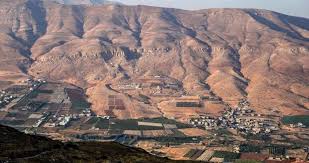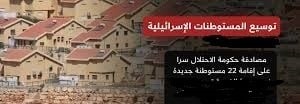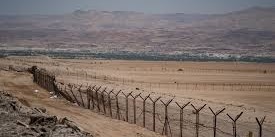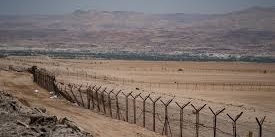By: Madeeha Al-A’raj
The National Bureau for defending land and resisting settlements ( nbprs ) stated in its latest weekly report , that the settlement expansion plan, annexing large areas of Palestinian lands to the Israeli occupation state, and imposing the laws and sovereignty of the State of Israel over them is still at the Israeli government’s agenda. As for the controversy surrounding the Israeli government’s stopping the annexation of large areas of land to the occupying State after the announcement of the Emirati-Israeli-American normalization agreement, the former American envoy to the Middle East, Jason Greenblatt, said that he believed that the Israeli plan to annex areas in the West Bank “is still valid and has not been removed but was suspended. He expressed his hope that the implementation of the plan would be “just a matter of time,” noting that it will be implemented. Soon. In this context, the Israeli PM Netanyahu, reiterated that Israel did not give up its plan to annex areas in the occupied West Bank, and that he did not choose between the agreement with the UAE and the annexation plan.
He stressed that the annexation plan will be implemented with American support. Netanyahu emphasized that the implementation of the annexation plan is still strongly present on the agenda of his government and the agenda of the US President Trump. He pointed out that the delay in implementing the plan came in response to an American desire, and the agreement with the UAE will not affect this context. Meanwhile, Israeli Energy Minister, Yuval Steinitz said that the annexation plan will be implemented in full, but gradually.
Netanyahu close circle said, the annexation plan is suspended in order to pass the agreement with the Emirates, but they call for the adoption of a national plan for intensive settlement development for the Jordan Valley, and to transform Ma’aleh Ephraim into a city, and to establish new settlements in the Jordan Valley with great government investment and development in agriculture, tourism and high technology, and to divert road 90 to highway that parallel to road 6, from the eastern Galilee and the Golan, through the Jordan Valley to Eilat, in anticipation, as these circles say, to future expectations in 2048, as the State of Israel’s population will reach 20 million.
In the context, the Civil Administration of the Occupation Army launched a new wave of settlement activities, and its approval of settlement projects in the E1 area to link the so-called Binyamin settlement bloc in Ramallah and Al-Bireh Governorate with Jerusalem by constructing a highway, and another project to link road no. 60, designated for the use of settlers from the settlements of Adam, Psagot, Beit El and Ofra to reach Jerusalem directly, and the construction of another road between the settlement bloc, Binyamin, and occupied Jerusalem, extending from the settlement. Adam until the Hizma checkpoint northeast of Jerusalem, and the paving the way for the establishment of a settlement industrial zone on lands of Sho’fa, Jbara and Al-Ras, south of Tulkarm, first paving roads in Shofa lands, where a road was completely built around the” Al-Wastani Mountain.
Within the context, human rights organizations within the Green Line responded to the construction plan in Area E1 by calling on the Palestinian and Israeli public to expedite the submission of objections to the Supreme Planning Council in the military government in the settlement of Beit El i.e. the Israeli Civil Administration on the project before the expiration of the period of objection. Peace Now, Ir Amim and the Association for Justice have jointly objected at the Higher Planning Council of the Civil Administration against building plans for about 3,500 housing units in E1, and in parallel it launched a campaign with the non-governmental organization “Micazepam’ calling for the public to sign the objectiont, within a few days, more than 1,500 objectors had already signed, before the expiration of the period of the objection to this dangerous settlement project that divides the West Bank into two parts, northern and southern, eliminating geographical contact in the West Bank and isolating Jerusalem.
In the northern valleys, the Israeli occupation forces raided the village of Atouf, and delivered notices to remove facilities for citizens in the Baqi’ah Plain under the pretext of not being licensed, knowing that they were built on private Palestinian land.
List of Israeli Assaults over the Last Week, Documented by the National Bureau:
Jerusalem:
- Demolishing a wall under construction in the Hizma town, northeast of Jerusalem.
- Notification of demolishing other facilities in the Al-Jadira town.
- Demolishing a wall surrounding a two dunums land in the Hizma town built in 2017 under the pretext of not having a building permit.
- Notification of demolishing a pool of water, a sheep barn and a wall surrounding the lands of citizens in the Wadi Hassan area of the Al-Jadira town northwest of Jerusalem, under the pretext of not having a building permit.
Ramallah:
- Issuing 13 stop construction in the Bedouin Al Ka’bneh community, east of Ramallah, in the Ras al-Tin area, east of the Kafr Malik village.
- Numbers of Palestinian were suffocated by Israeli gas tear bombs during the weekly march of Neilin village, west of Ramallah.
Hebron:
- Attacking property of a Palestinian in the Azba of Wade al-Sawi east of Yatta, destroyed a sheep-tent, water tanks, and stole other residential houses.
Nablus:
- Killing Iqab Darawsha, from the Taloza town in Nablus after being run over by an Israeli settler near a southern barrier of Jbara in Tulkarm.
- Breaking into archeological sites in the Sabastia town, north of Nablus, clashes took place in which a number of Palestinian were suffocated. Handing notice of the removal of 16m Palestinian flag mast in the Al-Baider square, in the town.
- Breaking into the eastern neighborhood of the Asira Al-Qabalyia town, clashes took place in which a number of Palestinian were suffocated.
Tulkarm:
- Bulldozing agricultural lands, most of which cultivated with olive trees and almonds.
- Building a new road in the Al-Wastani Mountain area, in the Shofa village, southeast of Tulkarm, noting that the ownership of the mountain belongs to the families of the Shofa village and is registered in their names on the official identification papers. The area falls within the plans approved by the Israeli authorities at the end of last year, which will lead to the confiscation of hundreds of dunams of agricultural land between the Jbara and Shofah villages.
Jordan valley:
- Demolishing a 150m agricultural barn in less than 96 hours after receiving a demolition notice in the Attouf village, under the pretext of locating in an illegal area, knowing that the barn located within the structural plan of the Attouf village under the of being protected areas.
 المكتب الوطني للدفاع عن الارض ومقاومة الاستيطان منظمة التحرير الفلسطينية
المكتب الوطني للدفاع عن الارض ومقاومة الاستيطان منظمة التحرير الفلسطينية




